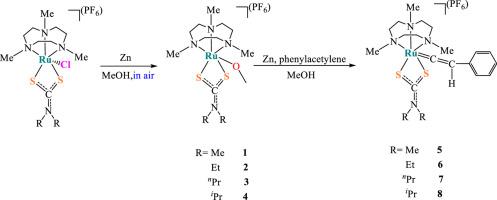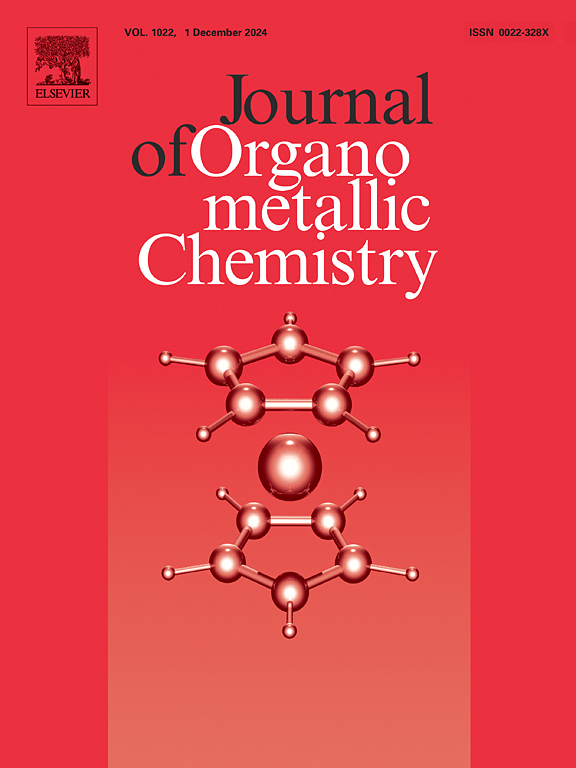Ruthenium methoxy and ruthenium vinylidene complexes featuring dithiocarbamate ligands
IF 2.1
3区 化学
Q3 CHEMISTRY, INORGANIC & NUCLEAR
引用次数: 0
Abstract
Treatment of [(Me3tacn)RuIII(κ2-S2CNR2)Cl]PF6 (Me3tacn = 1,4,7-trimethyl-1,4,7-triazacyclononane) with methanol in the presence of zinc powder in air afforded four ruthenium methoxy complexes [(Me3tacn)RuIII(κ2-S2CNR2)(OCH3)]PF6 (R = Me 1, Et 2, nPr 3, iPr 4). Further reactions of complexes 1–4 and phenylacetylene gave four ruthenium vinylidene complexes [(Me3tacn)(κ2-S2CNR2)Ru=C=CHPh]PF6 (R = Me 5, Et 6, nPr 7, iPr 8). Molecular structures of complexes 1, 2, 3, 6, 7 and 8 were established by single crystal X-ray diffraction analysis. Moreover, all complexes were characterized by infrared, UV–vis, fluorescence and mass spectrometry, and their electrochemical properties were also investigated. The visible-light-induced catalytic properties of complexes 5–8 for H2 evolution by water splitting were explored.

具有二硫代氨基甲酸酯配体的甲氧基钌和亚乙烯基钌络合物
在空气中,在锌粉存在下,用甲醇处理[(Me3tacn)RuIII(κ2-S2CNR2)Cl]PF6(Me3tacn = 1,4,7-三甲基-1,4,7-三氮杂环壬烷),得到四个甲氧基钌络合物[(Me3tacn)RuIII(κ2-S2CNR2)(OCH3)]PF6(R = Me 1, Et 2, nPr 3, iPr 4)。络合物 1-4 与苯乙炔进一步反应,得到四个亚乙烯基钌络合物 [(Me3tacn)(κ2-S2CNR2)Ru=C=CHPh]PF6(R = Me 5、Et 6、nPr 7、iPr 8)。通过单晶 X 射线衍射分析,确定了复合物 1、2、3、6、7 和 8 的分子结构。此外,还利用红外光谱、紫外-可见光谱、荧光光谱和质谱对所有配合物进行了表征,并研究了它们的电化学性质。研究还探讨了 5-8 复合物在可见光诱导下通过水分裂进化 H2 的催化特性。
本文章由计算机程序翻译,如有差异,请以英文原文为准。
求助全文
约1分钟内获得全文
求助全文
来源期刊

Journal of Organometallic Chemistry
化学-无机化学与核化学
CiteScore
4.40
自引率
8.70%
发文量
221
审稿时长
36 days
期刊介绍:
The Journal of Organometallic Chemistry targets original papers dealing with theoretical aspects, structural chemistry, synthesis, physical and chemical properties (including reaction mechanisms), and practical applications of organometallic compounds.
Organometallic compounds are defined as compounds that contain metal - carbon bonds. The term metal includes all alkali and alkaline earth metals, all transition metals and the lanthanides and actinides in the Periodic Table. Metalloids including the elements in Group 13 and the heavier members of the Groups 14 - 16 are also included. The term chemistry includes syntheses, characterizations and reaction chemistry of all such compounds. Research reports based on use of organometallic complexes in bioorganometallic chemistry, medicine, material sciences, homogeneous catalysis and energy conversion are also welcome.
The scope of the journal has been enlarged to encompass important research on organometallic complexes in bioorganometallic chemistry and material sciences, and of heavier main group elements in organometallic chemistry. The journal also publishes review articles, short communications and notes.
 求助内容:
求助内容: 应助结果提醒方式:
应助结果提醒方式:


